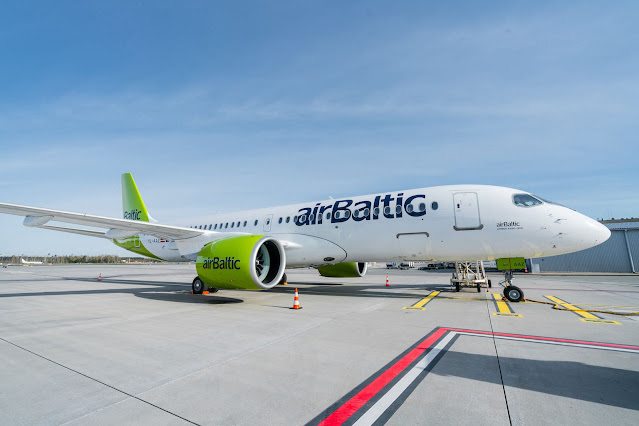airBaltic sees new opportunities in Western Balkans
Latvia’s national carrier airBaltic has expanded its presence in the region this year with the launch of new routes to Belgrade, Tivat, Split and Dubrovnik. However, the carrier sees additional opportunities to grow. Nikodem Szczygłowski, an independent journalist, traveller, translator (Slovenian, Lithuanian, Polish) and author spoke to Mantas Vrubliauskas, airBaltic’s Vice President for Network Development about the airline’s new routes in the region, further expansion opportunities in the Balkans, cooperation with Air Serbia and Croatia Airlines, as well as the state of the Slovenian aviation market.
This year you launched routes to Belgrade and Bucharest, as well as Tivat in Montenegro - which has become another Adriatic destination in your network alongside Dubrovnik, Split and Rijeka. Are you considering further expanding your route network in the region?
We find that this region is becoming increasingly interesting, and I do not mean only the destinations on the Adriatic coast. We believe we can offer a good connecting product between this region and destinations in the Baltic and Nordic countries. In fact, we already see this working quite well on our new destinations to Romania, Serbia and Montenegro. We are working to evaluate further opportunities in this region, and I expect we will be able to offer more connectivity here, which will also help us to further offset the traffic losses from Russia and Ukraine.
When it comes to the Western Balkan region, so far, your attention has been focused exclusively on coastal destinations in Croatia. What has changed now that you have started flying to Belgrade and are considering other destinations - beyond Dalmatia and Istria?
There are many reasons for this. First of all, our fleet is growing, and we are also looking for ways to grow our network. Secondly, the war in Ukraine is forcing to us to look for new passenger flows. To give you an example, we continue serving the Nordic and Baltic capitals up to four times per day from Riga and sustaining such frequency on a 145-seater requires a lot of feeding capacity as well. Finally, this region is becoming more and more attractive for incoming tourists. There are now charter flights to Albania, for example, and tour operators are developing this market. Slovenia is also investing a lot in branding itself, and we actually get a lot of feedback from our customers asking for flights there, because it is actually really difficult to get to. Romania and Bulgaria are now some of the fastest growing economies in the EU, which reflects also on traffic figures, and we cannot ignore that.
What impact does the cooperation with Air Serbia have on making flights to Belgrade? Does this factor help when it comes to sales? If yes - which destinations from Air Serbia’s network are most interesting from your point of view?
Our long-standing codeshare with Air Serbia was an important factor when we made the decision to launch flights to Belgrade. We can see that Belgrade is becoming an important regional hub, both for flights to neighboring countries, and long-haul destinations. We already have some figures, and Tivat is the most popular destination beyond Belgrade on our Riga - Belgrade route. This might be because our new nonstop Tivat flights are also performing quite well, and it is hard to find an empty seat.
You have also had cooperation with Croatia Airlines on an interline basis for years. How helpful is it at the moment for the airline? Is Zagreb, following Ryanair’s entry, interesting as a potential destination from your point of view?
We are very satisfied with our cooperation with Croatia Airlines. Croatia is an important market (and the largest market from the Baltic countries in this region) and having a partner on the other side helps us tremendously. As one of the most vocal ambassadors of the Airbus A220 program, we were very happy to see that Croatia Airlines has chosen the A220 for their fleet renewal. This aircraft is a key to our success story, and I think it will be instrumental for the success of Croatia Airlines too, especially if you talk about the competitive landscape in Zagreb. The A220 is a very efficient, and, at the same time, a versatile aircraft, and it is perfectly sized for a market such as Latvia, or Croatia. I am not fully familiar with Ryanair’s expansion in Zagreb, but I think one single airline cannot serve all market segments, and therefore Zagreb remains an interesting market opportunity for us.
Following the bankruptcy of Adria Airways, Slovenia is one of the worst-connected aviation markets in the European Union. The country is still debating whether it needs a new national carrier. What is your opinion - is there really a need for a new national carrier in Ljubljana? Could Slovenia be an interesting market for airBaltic?
I think we can all agree that air connectivity in Slovenia should be improved, but I am not sure if a national carrier is the answer. The market forces within the EU’s single aviation market will inevitably lead to the consolidation of airlines, and only the fittest carriers will survive. Having said that, economic development is so closely linked to air connectivity, and countries should do more to increase it. I think it is difficult to solve this, but countries should find legal mechanisms to incentivise airlines (for example, PSO schemes or similar), they should invest into airports and make them commercially attractive, and they should also do a lot of destination marketing. I think Slovenia is doing quite a lot already in all of these areas, and I sincerely hope they will soon see the results. Slovenia is definitely interesting for us too, and I think A220s is the right aircraft type for this market.











0 Response to "airBaltic sees new opportunities in Western Balkans"
Post a Comment